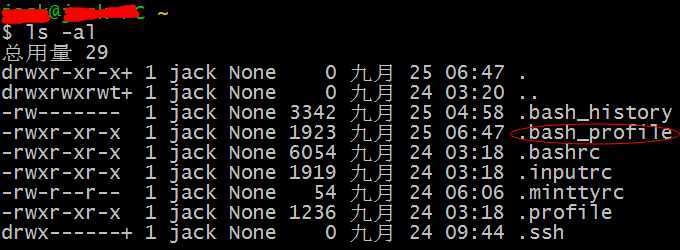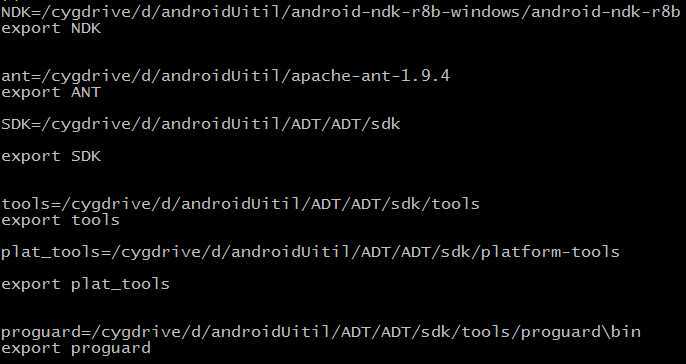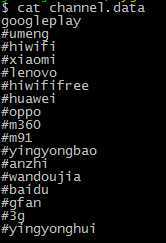标签:android style blog http color io os java ar
运行环境:Windows7 + Cygwin + ant
这种方式比较 简单。利用ant打包。
直接shell脚本修改 配置渠道号的文件。
我们目前是用的umeng的。在AndroidManifest.xml里。
提供一个简单的修改渠道号的脚本。
配置:
1.环境变量配置:
(1)cd~ 或 cd /home 进入用户目录

其中.bash_profile文件为配置文件。
(2)输入cat .bash_profile查看该文件

其中配置了ndk路径,ant路径,sdk相关路径,也可以写成export PATH=/cygdrive/d/androidUitil/ADT/ADT/sdk/tools:{$PATH}样式,启动cygdrive在CygWin中代表磁盘。
2.项目文件配置【放置于项目根目录,与src目录同级】
(1)ant.properties 文件
# This file is used to override default values used by the Ant build system. # # This file must be checked in Version Control Systems, as it is # integral to the build system of your project. # This file is only used by the Ant script. # You can use this to override default values such as # ‘source.dir‘ for the location of your java source folder and # ‘out.dir‘ for the location of your output folder. # You can also use it define how the release builds are signed by declaring # the following properties: # ‘key.store‘ for the location of your keystore and # ‘key.alias‘ for the name of the key to use. # The password will be asked during the build when you use the ‘release‘ target. key.store=【签名文件绝对路径】 key.store.password=【签名密码】 key.alias=【别名】 key.alias.password=【签名密码】
(2)local.properties文件
# This file is automatically generated by Android Tools. # Do not modify this file -- YOUR CHANGES WILL BE ERASED! # # This file must *NOT* be checked into Version Control Systems, # as it contains information specific to your local configuration. # location of the SDK. This is only used by Ant # For customization when using a Version Control System, please read the # header note. sdk.dir=【sdk绝对路径】
(3)build.xml文件
<?xml version="1.0" encoding="UTF-8"?> <project name="【项目名称】" default="help"> <!-- The local.properties file is created and updated by the ‘android‘ tool. It contains the path to the SDK. It should *NOT* be checked into Version Control Systems. --> <property file="local.properties" /> <!-- The ant.properties file can be created by you. It is only edited by the ‘android‘ tool to add properties to it. This is the place to change some Ant specific build properties. Here are some properties you may want to change/update: source.dir The name of the source directory. Default is ‘src‘. out.dir The name of the output directory. Default is ‘bin‘. For other overridable properties, look at the beginning of the rules files in the SDK, at tools/ant/build.xml Properties related to the SDK location or the project target should be updated using the ‘android‘ tool with the ‘update‘ action. This file is an integral part of the build system for your application and should be checked into Version Control Systems. --> <property file="ant.properties" /> <!-- if sdk.dir was not set from one of the property file, then get it from the ANDROID_HOME env var. This must be done before we load project.properties since the proguard config can use sdk.dir --> <property environment="env" /> <condition property="sdk.dir" value="${env.ANDROID_HOME}"> <isset property="env.ANDROID_HOME" /> </condition> <!-- The project.properties file is created and updated by the ‘android‘ tool, as well as ADT. This contains project specific properties such as project target, and library dependencies. Lower level build properties are stored in ant.properties (or in .classpath for Eclipse projects). This file is an integral part of the build system for your application and should be checked into Version Control Systems. --> <loadproperties srcFile="project.properties" /> <!-- quick check on sdk.dir --> <fail message="sdk.dir is missing. Make sure to generate local.properties using ‘android update project‘ or to inject it through the ANDROID_HOME environment variable." unless="sdk.dir" /> <!-- Import per project custom build rules if present at the root of the project. This is the place to put custom intermediary targets such as: -pre-build -pre-compile -post-compile (This is typically used for code obfuscation. Compiled code location: ${out.classes.absolute.dir} If this is not done in place, override ${out.dex.input.absolute.dir}) -post-package -post-build -pre-clean --> <import file="custom_rules.xml" optional="true" /> <!-- Import the actual build file. To customize existing targets, there are two options: - Customize only one target: - copy/paste the target into this file, *before* the <import> task. - customize it to your needs. - Customize the whole content of build.xml - copy/paste the content of the rules files (minus the top node) into this file, replacing the <import> task. - customize to your needs. *********************** ****** IMPORTANT ****** *********************** In all cases you must update the value of version-tag below to read ‘custom‘ instead of an integer, in order to avoid having your file be overridden by tools such as "android update project" --> <!-- version-tag: 1 --> <import file="${sdk.dir}/tools/ant/build.xml" /> </project>
3.渠道列表文件channel.data

4.编写shell脚本 apkList.sh文件

5.执行shell脚本
进入apkList.sh文件所在目录,执行./apkList.sh,即开始批量打包
由于我们用上了爱加密,所以也只能用这种方式了。
由于现在我们的渠道较少,所以是采纳了apktool 的方式。
第一步:反编译
java -jar apktool.jar d com.hiwifi.hiwifi_20140801181424.apk
第二步:修改渠道号
sed -i .bak ‘145s/.*/<meta-data android:name="UMENG_CHANNEL" android:value="‘${channel}‘" \/>/‘ tobuild/AndroidManifest.xml
第三步:重新编译
java -jar apktool.jar b com.hiwifi.hiwifi_20140801181424 com.hiwifi.hiwifi_lenovo.apk
我在重新编译时遇到如下错误:
I: Checking whether sources has changed... I: Checking whether resources has changed... I: Building resources... Exception in thread "main" brut.androlib.AndrolibException: brut.androlib.AndrolibException: brut.common.BrutException: could not exec command: [aapt, p, --min-sdk-version, 11, --target-sdk-version, 19, -F, /var/folders/7r/ghlhnsm56fn9d3zwwmznrh9w0000gn/T/APKTOOL4414016803544356394.tmp, -0, arsc, -I, /Users/shunpingliu/Library/apktool/framework/1.apk, -S, /Users/shunpingliu/GreenSoftware/apktool/com.hiwifi.hiwifi_20140801181424/res, -M, /Users/shunpingliu/GreenSoftware/apktool/com.hiwifi.hiwifi_20140801181424/AndroidManifest.xml] at brut.androlib.Androlib.buildResourcesFull(Androlib.java:358) at brut.androlib.Androlib.buildResources(Androlib.java:283) at brut.androlib.Androlib.build(Androlib.java:206) at brut.androlib.Androlib.build(Androlib.java:176) at brut.apktool.Main.cmdBuild(Main.java:228) at brut.apktool.Main.main(Main.java:79) Caused by: brut.androlib.AndrolibException: brut.common.BrutException: could not exec command: [aapt, p, --min-sdk-version, 11, --target-sdk-version, 19, -F, /var/folders/7r/ghlhnsm56fn9d3zwwmznrh9w0000gn/T/APKTOOL4414016803544356394.tmp, -0, arsc, -I, /Users/shunpingliu/Library/apktool/framework/1.apk, -S, /Users/shunpingliu/GreenSoftware/apktool/com.hiwifi.hiwifi_20140801181424/res, -M, /Users/shunpingliu/GreenSoftware/apktool/com.hiwifi.hiwifi_20140801181424/AndroidManifest.xml] at brut.androlib.res.AndrolibResources.aaptPackage(AndrolibResources.java:357) at brut.androlib.Androlib.buildResourcesFull(Androlib.java:336) ... 5 more Caused by: brut.common.BrutException: could not exec command: [aapt, p, --min-sdk-version, 11, --target-sdk-version, 19, -F, /var/folders/7r/ghlhnsm56fn9d3zwwmznrh9w0000gn/T/APKTOOL4414016803544356394.tmp, -0, arsc, -I, /Users/shunpingliu/Library/apktool/framework/1.apk, -S, /Users/shunpingliu/GreenSoftware/apktool/com.hiwifi.hiwifi_20140801181424/res, -M, /Users/shunpingliu/GreenSoftware/apktool/com.hiwifi.hiwifi_20140801181424/AndroidManifest.xml] at brut.util.OS.exec(OS.java:93) at brut.androlib.res.AndrolibResources.aaptPackage(AndrolibResources.java:355) ... 6 more Caused by: java.io.IOException: Cannot run program "aapt": error=2, No such file or directory at java.lang.ProcessBuilder.processException(ProcessBuilder.java:478) at java.lang.ProcessBuilder.start(ProcessBuilder.java:457) at java.lang.Runtime.exec(Runtime.java:593) at java.lang.Runtime.exec(Runtime.java:466) at brut.util.OS.exec(OS.java:84) ... 7 more Caused by: java.io.IOException: error=2, No such file or directory at java.lang.UNIXProcess.forkAndExec(Native Method) at java.lang.UNIXProcess.<init>(UNIXProcess.java:53) at java.lang.ProcessImpl.start(ProcessImpl.java:91) at java.lang.ProcessBuilder.start(ProcessBuilder.java:452) ... 10 more
解决办法:
把aapt加到环境变量里去,这个命令在sdk中。
我机器上代码如下: vim ~/.bash_profile 增加以下内容:(和各自的文件位置有关)
export PATH="/Users/shunpingliu/GreenSoftware/adt-bundle-mac-x86_64-20140321 /sdk/build-tools/android-4.4.2:$PATH"
然后使配置生效
source .bash_profile
完整版脚本参考附件。
1 #!/bin/bash 2 apktool="/Users/shunpingliu/GreenSoftware/apktool/apktool.jar" 3 #channellist="channel.data" 4 channellist="channel.data" 5 ijiamifile="/Volumes/MacintoshHD/Users/liushunping/station/apk/com.hiwifi.hiwifi_20140801181424_yingyongbao.apk" 【爱加密之后的apk文件】 6 java -jar $apktool d -f $ijiamifile tobuild 7 for channel in $(cat $channellist) 8 do 9 sed -i .bak ‘145s/.*/<meta-data android:name="UMENG_CHANNEL" android:value="‘${channel}‘" \/>/‘ tobuild/AndroidManifest.xml 10 java -jar $apktool b tobuild com.hiwifi.hiwifi_$channel.apk 11 done
标签:android style blog http color io os java ar
原文地址:http://www.cnblogs.com/Jack-Lu/p/3992987.html